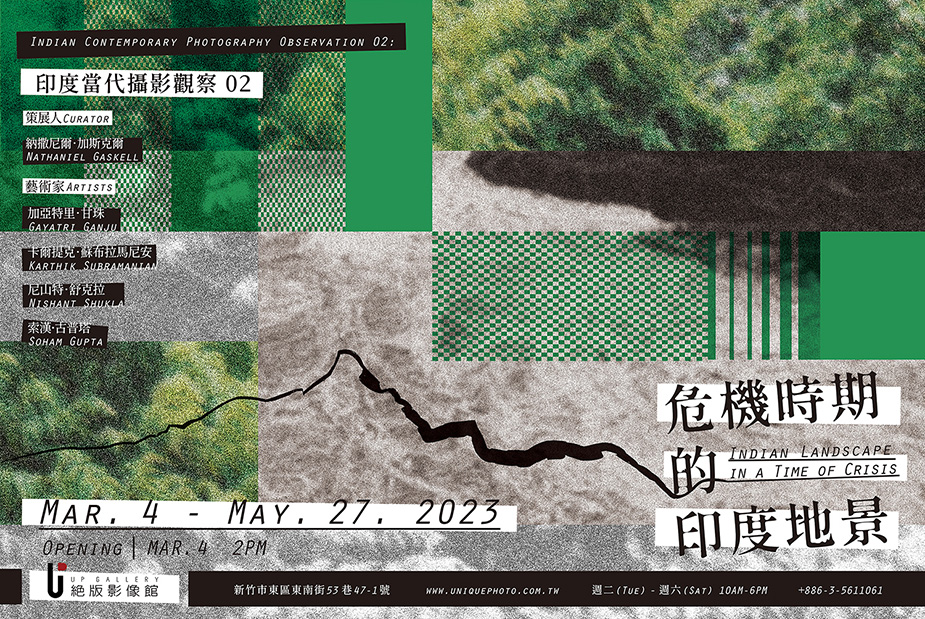EXHIBITIONS
Exhibition ─ Current
Indian Contemporary Photography Observation 02: Indian Landscape in a Time of Crisis
Indian Contemporary Photography Observation 02: Indian Landscape in a Time of Crisis
Duration: 2023/03/04-05/27
Opening: 03/04 (SAT) 14:00
Curator: Nathaniel Gaskell
Artists: Gayatri Ganju, Karthik Subramanian, Nishant Shukla, and Soham Gupta
Venue: UP Gallery
In the early months of the ongoing COVID-19 pandemic, not long after India enforced an initial spate of lockdowns, Delhi Whatsapp groups began to crowd—unexpectedly—with images of blue skies. In a metropolis recognised the world over for its toxic haze, the return of a clear sky was confusing, pushing its residents to speak out on social media. “Good?” one message read, referring to the air, “it’s positively alpine!” Albeit a response to a refreshing change in a traffic-choked city, such enthusiasm also demonstrates our fraught relationship with nature; one that is often expressed through photographs.
The images of emptier cities and bluer skies from the time of the pandemic tell us a story about ourselves, making us unwitting spectators of our own absence in the natural order of things. Depopulated landscapes, abandoned and seemingly overgrown, suggested a return to nature. Though they weren’t really deserted at all, but filled with something else entirely—a projection of meaning more to do with us than our environment.
Through the tools of metaphor, symbolism, narrative and assumed documentary truth, photographers over time have wrestled with the tensions inherent in our spectatorship of the natural world. To what extent is a photograph of a landscape simultaneously inventing that landscape in our own image? How is our relationship to nature changing in light of global heating and a now-complete realisation that time is running out? Do the older conceptions of pure and perfect landscapes bear any relation to a world undergoing a very real and visible degradation? All photographs of the natural world today are unavoidably tainted by the knowledge of the precarious balance on which our environment stands.
The four photographers in this exhibition explore, in distinct but comparable ways, the possibilities inherent in representing and engaging with natural landscapes and their associated contexts and possibilities. At this time of environmental crisis and collapse, older ideas of the timeless and sublime picturesque have become charged with overlapping fields of meaning—politics, mythology, metaphor, communal history, personal sentiment—and pose to their chroniclers a deeper challenge of imagination.
Karthik Subramanian’s photographs of the Kaveri river in southern India, which he made through the course of a 72-day long walk along both its banks for the series Idai Veli (meaning “gap” in Tamil), is an attempt to redefine a river he has known since he was a child. Due to its position between the states of Tamil Nadu and Karnataka, the question of who owns the Kaveri is politically fraught, added to the precarious nature of its flow—once drought-prone and more recently vulnerable to flooding. At the heart of this question are people whose livelihoods, identities and cultural histories depend on a river that is often governed as a line on a map. Subramanian’s monochromatic images have an unrestrained proximity to their subject, attempting to move beyond political cartography and enact a kind of sensorial mapping inspired by his grandparents’ stories, folktales and the traditions of Sangam poems.
Further north in the subcontinent, over 2,000 kilometres away, we find the setting for Nishant Shukla’s series Seeking Moksha, which began in 2011 with a pilgrimage to the source of another river—the Ganga in the Himalayas, undertaken with the purpose of collecting water for his grandfather, a Hindu priest on his deathbed. On his return, however, his grandfather had lost all memory of Shukla, prompting a deeper and more private search for the root of the compulsions in us all to look for meaning—and at times, ourselves—in treacherous and sublime natural expanses. He returned multiple times after the incident, often fantasising about becoming a hermit himself, bringing back material traces from his journeys, including wildflowers, earth, stone and, of course, several photographs. People rarely appear in these images, but their yearning, desire and internality is at the heart of his approach, where, as he puts it, the landscape can act as a “blank canvas” for the possibilities and failures inherent in human quests.
Currently based in the mountain ranges of the Nilgiris, Gayatri Ganju’s work expresses an atavistic and personal sense of co-existence with the landscapes she photographs. Her work The Dragon and the Goat emerged from a six-week residency in southern Switzerland, and engaged with the lush wilderness of the Verzasca Valley and her place as a visitor within it. Many of her monochromatic images were made at night, using external flashes and long exposures—including those of the trees on display—extracting from their surface a layer of postcard-like beauty that one has come to expect from the region; and also one that has had a history as an idyllic landscape in the Indian imagination over the last century. Ganju’s dynamic and exploratory style invites the viewer in, sharing with them her vision for and connection with the landscape in all its vast, powerful, dark, beautiful and fragile intensity. Like for Subramanian and Shukla, walking is central to her work, and her moody and feverish images reflect the paradoxical sense of control and unruliness that being alone in landscapes engenders. “It was liberating to walk at night as an Indian woman,” she adds, “knowing I was the most dangerous thing around.”
While natural landscapes can serve as canvases for our personal projections and explorations, they are also equally, and crucially, inhabited spaces with evolving social and communal histories; spaces over which networks of metamorphoses, migrations and marginalisations play out in large and small ways. Soham Gupta’s two series Eden and Angst—though distinct in their approach and emotional tenor—attempt to grasp the slippage between the personal and the social, violence and negligence and anger and cynicism, while also challenging the overly rigid distinctions between portraits of people and places. Gupta first produced Angst, a project that earned him international attention for his focus on the underbelly of Kolkata through a set of nocturnal, gritty and attentive portraits of those at its margins. Eden, on the other hand, has a gentler touch, more poetic and premeditated. The photographs depict a fictitious urban landscape ruined and reclaimed by overgrown nature. Themes of entropy and decay dominate both series, and their evocative power stems from their ability to hint, but never explicitly state, their terms of engagement for the viewer. As Gupta says: “What gives one a feeling of hauntedness? Probably something that’s not clearly stated, that is shrouded in mystery, that is not explicit.” Gupta’s photographs reflect this preoccupation, wherein the landscape isn’t simply a space for external reflection or extrapolation, but one of confrontation and unnerving intimacy—almost corporeal in its connection to us and the stories we tell ourselves.
Through their individual approaches, the bodies of work discussed here both behold and problematise beauty as the principal system of valuing natural landscapes through photography. As John Berger once wrote of the English countryside, “sometimes a landscape seems to be less a setting for the life of its inhabitants than a curtain behind which their struggles, achievements and accidents take place.” This exhibition offers us one way of looking behind that curtain.
About the Curator
Nathaniel Gaskell (b. 1986) Born in London and based in Singapore, Nathaniel Gaskell is the founder and director of the MAP Academy — the education arm of the Museum of Art & Photography (MAP), Bengaluru — and the director of Cara Consulting, Singapore. Following a Master’s degree in research (Interdisciplinary Studies) at the London Consortium, Gaskell has been an editor and author of various research projects and publications on South and Southeast Asian art and culture, including Jyoti Bhatt: Time & Time Again (MAP), Photography in India: A Visual History from the 1850s to the Present (Prestel), co-authored with Dr. Diva Gujral; Hikari: Contemporary Photography from Japan (Japan Foundation); Derry Moore: In the Shadow of the Raj (Prestel/ Random House); William Dalrymple: The Historian’s Eye (HarperCollins); Maharanis: Women from Royal India (Mapin); and Goh Beng Kwan: Nervous City (National Gallery Singapore), authored by Joleen Loh. He has been a jury member for the TFA photography prize (2015–18) and the Sienna Awards (2021), as well as a nominator for the Kyoto Art Prize (2019), the Prix Pictet Award (2017–21), the Sher-Gil Sundaram grant for photography (2021), and is a fellow of the Royal Asiatic Society.
About the Artists
Gayatri Ganju (b. 1989) is based in Bangalore, India. Her work lies at the intersection between gender, mythology and the natural world. She graduated from the London College of Communication with a Masters in Documentary Photography, in 2013 and has since worked as an editorial photographer. Her personal practice is rooted in a deep and tangled relationship with landscape. She uses the act of walking as a tool to peel through the outer and inner landscapes she finds herself in.
Karthik Subramanian (b.1985) works with both photography and film to explore the threads connecting humans to the land, water and all other animate and inanimate beings. As a child, Subramanian travelled frequently between his life in the city and his grandparents’ in the village – learning to experience the world as it moves through the window of a train.
When he later travelled to photograph the Sundarbans, a place where the river Ganga joins the Bay of Bengal, the scenes of the shifting land in front of him mixed inseparably with his lingering memories of the landscape through the moving windows. At this slippery edge between water and land, began Subramanian’s preoccupation with still and moving images; culture and ecology; memory and history; the end and the beginning.
His works have been a part of Hong Kong International Photo Festival, (Hongkong, 2021); Chobi Mela X (Bangladesh, 2020); Ellipsis, Jawahar Kala Kendra (India, 2019); Chennai Photo Biennale (India, 2019); Artists Unite! (Red Fort-Delhi, India 2019); A Million mutinies later – India at 70, FFotoGallery (Wales, 2017); Serendipity Arts Festival (India, 2016); Unseen Amsterdam (Netherlands,2015); Angkor Photo Festival (Cambodia, 2014).
Nishant Shukla (b.1982) is a photographer and artist based in London. He has a deep interest in the photobook as a medium. He co-founded BIND (2015-2020), a platform for photography and a library, examining the photobook as an art object. He received The Alkazi Foundation for the Arts: Photobook grant (2016), which enabled the publication of his first book. Seeking Moksha (2017) explores the search for transcendence through a collection of photographs, written notes, found objects and sound that memorialise his own experience.
Nishant’s practice is guided by a documentary approach, where he makes portrait, still life and landscape studies. The act of seeking is a central motif in his work, which engages with the struggle for purpose and meaning. By presenting his own personal journey, Nishant invites the viewer to contemplate their own path.
Nishant received the DYCP (Develop your Creative Practice) grant by the Arts Council England (2021) through which he is exploring a sonic art practice to expand on his current work.
Soham Gupta (b. 1988) is based in Kolkata and makes work that constantly moves between the realm of documentary photography, art and the written word. He responds to themes of loneliness and isolation, of abuse and pain, of scarred pasts and uncertain futures, sexual tensions and existential dilemmas.
In 2018, Soham was selected by The British Journal of Photography as one of sixteen emerging photographers from more than 500 nominations made by a global panel of experts. In the same year, his book Angst, published by Akina Books, was shortlisted for the Les Prix du Livre: Photo and Text Book Award at Les Rencontres d’Arles and the Paris Photo – Aperture Foundation First Photobook Award.
He was one of the invited artists participating at the 58th La Biennale di Venezia curated by Ralph Rugoff in 2019. In the same year, Museum Folkwang in Essen, Germany acquired twenty images from the series, Angst.



